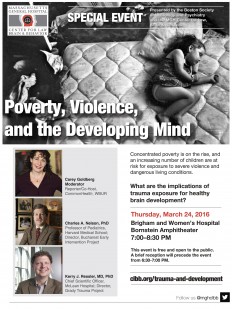By Galen Chin-Lun Hung, Jill Hahn, Bibi Alamiri, Stephen L. Buka, Jill M. Goldstein, Nan Laird, Charles A. Nelson, Jordan W. Smoller, and Stephen E. Gilman | International Journal of Epidemiology | December 16, 2015
Abstract:
Background: Early social experiences are believed to shape neurodevelopment, with potentially lifelong consequences. Yet minimal evidence exists regarding the role of the social environment on children’s neural functioning, a core domain of neurodevelopment.
Methods: We analysed data from 36 443 participants in the United States Collaborative Perinatal Project, a socioeconomically diverse pregnancy cohort conducted between 1959 and 1974. Study outcomes included: physician (neurologist or paediatrician)-rated neurological abnormality neonatally and thereafter at 4 months and 1 and 7 years; indicators of neurological hard signs and soft signs; and indicators of autonomic nervous system function.
Results: Children born to socioeconomically disadvantaged parents were more likely to exhibit neurological abnormalities at 4 months [odds ratio (OR) = 1.20; 95% confidence interval (CI) = 1.06, 1.37], 1 year (OR = 1.35; CI = 1.17, 1.56), and 7 years (OR = 1.67; CI = 1.48, 1.89), and more likely to exhibit neurological hard signs (OR = 1.39; CI = 1.10, 1.76), soft signs (OR = 1.26; CI = 1.09, 1.45) and autonomic nervous system dysfunctions at 7 years. Pregnancy and delivery complications, themselves associated with socioeconomic disadvantage, did not account for the higher risks of neurological abnormalities among disadvantaged children.
Conclusions: Parental socioeconomic disadvantage was, independently from pregnancy and delivery complications, associated with abnormal child neural development during the first 7 years of life. These findings reinforce the importance of the early environment for neurodevelopment generally, and expand knowledge regarding the domains of neurodevelopment affected by environmental conditions. Further work is needed to determine the mechanisms linking socioeconomic disadvantage with children’s neural functioning, the timing of such mechanisms and their potential reversibility.
Read the full article here.




